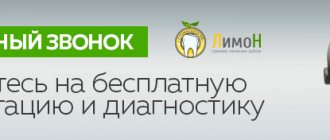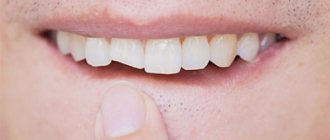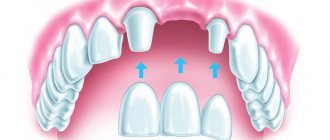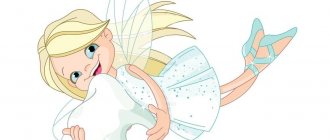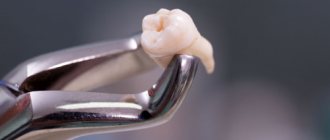Primary teeth are necessary so that, under the influence of occlusal load, a sufficient amount and volume of bone tissue is formed. Otherwise, permanent teeth simply would not be able to take root in the gums. Normally, a child's teeth are replaced in a certain order. As a result, the primary bite is replaced by a permanent one without pathologies.
Removal (extraction) of baby teeth only at first glance seems to be an absolutely simple procedure. If a baby tooth is lost long before a permanent tooth grows in its place, there is a risk of developing pathological changes in the bite. The decision to remove a child’s tooth must be made by a doctor.
Indications for tooth extraction in children
The absolute indications for the removal of baby teeth are:
- Neoplasms (cyst, phlegmon).
- Damage to the tooth with further development of a fistula.
- Severely advanced caries, as a result of which the crown of the tooth is completely destroyed.
- Chips and carious lesions in the crown of the tooth result in the formation of a sharp edge that injures the mucous membrane.
- Inflammation of the tissues adjacent to the tooth.
- The permanent tooth has already begun to erupt and the milk tooth interferes with it.
Causes of dental injury
A large or barely noticeable gap in the teeth area spoils the entire appearance. To treat and restore a tooth, you need to know the main causes of dental injury. There are several of them.
1. Mostly, children receive mechanical injuries from a fall or bruise, when parents see, for example, that a front tooth has broken at the root.
2. Children's teeth are not yet strong enough to experience serious jaw load. Therefore, it is worth making sure that children do not get used to, for example, clenching their teeth tightly.
3. If half of the tooth crown is broken, it is due to a poor-quality filling.
4. The filling or inlay may pop out or break when it reaches the end of its service life.
5. Teeth with thinned enamel become a risk area.
6. Due to thinned enamel, the tooth may be destroyed due to carious formation.
7. The quality and properties of food also affect tooth decay.
Avoid giving children foods that are too hard or rough. Even seeds can cause a piece of a tooth to break off. To avoid all these unpleasant consequences, you will need to pay more attention to care, as well as the quality of food.
To strengthen tooth enamel, you need a sufficient amount of calcium in the body. To strengthen the structure, remineralization is required. The appearance of microcracks is due to the fact that the child receives food that is too contrasting. This affects the condition of the enamel, it becomes vulnerable. A weakened tooth may break at some point. This is the result of exposure to food and ingestion of hot and frozen drinks.
Contraindications
It is not recommended to remove a child’s baby teeth in the following cases:
- Severe chronic conditions (heart defects, epilepsy, etc.).
- Inflammation in the oral cavity (stomatitis, gingivitis).
- Problems with blood clotting.
- Infectious diseases in the acute phase (ARVI, influenza, scarlet fever, chickenpox, etc.).
If there are contraindications, tooth extraction can be dangerous. But not all contraindications are absolute. For example, if the baby has an inflammatory process or an infectious disease, the tooth can be removed after treatment. The final decision about the procedure will be made by the dentist.
Symptoms
The patient cannot always see the preserved fragments and fragments of the tooth root. If they are severely damaged, they may be hidden by gum tissue. If the pathological process continues, symptoms occur:
- aching pain occurs in the area of a fallen or damaged tooth in the gum;
- when pressing on the problem area, sharp pain occurs;
- the gums swell, increase in volume, may turn red, and tissue may grow near the socket;
- bleeding appears at the site of the destroyed crown (spontaneous or due to mechanical impact);
- suppuration occurs and the temperature rises.
If any of these symptoms appear, you should immediately consult a dentist. They indicate a complicated inflammatory process. Without treatment, it can cause serious complications, including blood poisoning. Even if there are no symptoms described, tooth decay or collapse of the walls of the crown is a reason to urgently consult a doctor and undergo an x-ray.
Do you have questions about tooth extraction?
We will call you back within 30 seconds
+7
Removal without pain
In pediatric dentistry, it is very important to ensure the child’s comfort during the tooth extraction procedure. This applies to all stages of treatment. To prevent the baby from being afraid, double anesthesia is used:
- Anesthetic gel. It is necessary to reduce the sensitivity of the gums and prepare for further anesthesia.
- Injection anesthesia. After the gel begins to take effect, the nurse will inject an anesthetic into the gum. Thanks to the action of the gel, the child does not feel pain from the injection.
Many drugs for local anesthesia, which are used to anesthetize tooth extraction, are strong allergens. In order to exclude the possibility of an allergy, the child is given a skin test.
Typology of dental trauma
If a piece of a tooth breaks, the fragments can trap the enamel when destroyed. In these cases, the tooth breaks open or closed, and the pulp may open. Tooth injuries are distinguished by the area of the fracture - at the root, on top, etc. In case of injury, when a piece may break off, the tooth is often displaced.
The nature of the damage depends on the size of the chipped part, for example, if a child’s upper wisdom tooth is half broken:
- minimal degree of injury;
- average degree of injury;
- severe degree of injury.
When a tooth is damaged, the enamel is often affected. This is a minimal type of injury when the internal layers are not affected. The opposite indicates the average severity of the tooth fracture. In such a situation, the damage touches the pulp and the nerve is affected.
Let's look at the main types of dental damage. This is important for understanding what to do if a piece of a tooth breaks off.
1. The tooth broke in the root zone . The child’s tooth root is not yet strong enough to be difficult to remove.
The greatest risk, as always, falls on the upper front incisors. In order to determine why a child’s baby tooth has broken off, modern diagnostics will be required. A tooth fracture in the root area is determined by a series of x-rays. It is detected, as a rule, with the appearance of characteristic sensations due to inflammation of the gums. Depending on the degree of root destruction, the pulp will be affected, and this already leads to more serious consequences.
2. If a front tooth breaks off, and it is a baby tooth . Most often, a small piece breaks off from a small tooth. This can happen for various reasons. The doctor will determine the degree of danger. If the crown under the root is broken, the tooth will have to be removed. When a tooth chips away from the root, cosmetic restoration can be used to solve the problem. Usually the dentist performs extensions.
Often a tooth is displaced or dislocated as a result of a side blow to the jaw. For example, a child hit something when falling or another child accidentally touched it, and your child’s front tooth broke off. As a result, gum swelling may occur. The entry of microbes into the wound leads to the loss of a tooth, even if it is a milk tooth. It can be restored, but to do this it must be preserved in warm milk or saline until the implantation procedure.
Features of milk teeth removal
Milk teeth have their own characteristics:
- Thin alveolar walls.
- Weak, poorly defined neck.
- Divergence of roots in different directions.
To remove teeth, forceps with a slight fixation are used. The doctor grabs the crown with forceps, turns the tooth inside out and removes it from the socket. After this, the hole must be carefully inspected. Due to the structural features of baby teeth, there is a risk that part of the root or crown will remain in the socket. If everything is normal and there are no fragments in the hole, a sterile swab will be placed on the child’s wound. This helps stop bleeding faster and protects the wound.
The extraction procedure is quick. Thanks to double anesthesia, the baby does not feel pain at all. Removal is comfortable, without pain and fear.
What does a lost baby tooth look like (photos below)?
The difference between a baby tooth and a permanent tooth
Many parents, out of ignorance, tend to think that baby teeth do not have roots at all. At the same time, some mothers and fathers are horrified when a developed root system is not found on a lost baby tooth, believing that part of the tooth remains in the child’s gum. Brief information about what a lost baby tooth looks like will help dispel all the myths. A photo of the removed bone formation will provide the best idea of it.
Temporary incisors are identical to permanent incisors in structure, but differ in smaller crown sizes, thinner enamel and the presence of rather wide canals and large pulp. Despite numerous misconceptions, the root system of a baby tooth is present and ensures the proper performance of the functions of grinding food and forming a normal bite.
Pulled out milk tooth with root
The absence of roots in a fallen baby tooth is explained by their resorption at a certain stage of a person’s life to allow permanent bone structures to erupt, which is the norm.
Care after removal
In order for the wound to heal normally, you need to follow the recommendations for caring for your teeth after extraction. An infection can easily penetrate through an unhealed wound, which means that without care there is a risk of developing inflammation.
Caring for your child’s oral cavity is very simple:
- Immediately after removal, it is important to prevent the blood clot from being washed out of the socket. Therefore, the child should not eat or drink anything.
- The wound should be protected as much as possible from the risk of infection. You can't touch it with your hands. You need to make sure that the baby does not touch the hole. Penetration of infection can lead to the development of inflammation, suppuration and other complications.
- The first three days you need to do mouth baths. You can use medications that your surgeon recommends. Suitable decoctions of herbs with antiseptic and anti-inflammatory properties - sage, chamomile.
- The child’s diet should be monitored for the first five days. You should not eat solid food, cold and hot drinks, or confectionery.
If you follow these simple rules, a child almost never experiences complications after the removal of a baby tooth. In case of infection, you should immediately show the child to a doctor. You should come for examination if the following symptoms appear:
- Continuous bleeding. After removal of a dental unit, the wound may bleed for several hours. If the bleeding does not stop, you should consult a doctor.
- Bad breath. It may be a sign of developing inflammation or suppuration. The inflammatory process quickly spreads to other tissues, which can cause serious complications.
- Fever. Speaks of infection or inflammatory process. Immediately after surgery, your temperature may rise slightly. This is often due to the stress that the child experiences in the dental chair. If the temperature persists for a long time or rises during the healing process, you cannot delay a visit to the dental clinic.
Root canal treatment in children
The roots of children's baby teeth are filled with a special paste. It has the ability to dissolve in parallel with the process of resorption of hard tissues. This is the only way to ensure that the order of changing teeth is not disrupted and that there are no obstacles to the resorption of milk roots.
Once the root canals are treated, they are closed with a filling. Sometimes the doctor decides to use temporary filling material. This measure is justified if the likelihood of complications is high and you need to make sure that the inflammation has subsided. Only when the dentist is sure that everything is in order will he install a permanent filling.
How does removing baby teeth affect your bite?
Removing baby teeth can be dangerous for the bite if the permanent teeth have not yet begun to emerge. The prolonged absence of a dental unit leads to the fact that neighboring ones begin to move, filling the empty space. When permanent teeth begin to emerge, they run out of space. This leads to the development of various bite defects.
When removal cannot be avoided, it is recommended to install special artificial crowns. This way you can avoid tooth movement and changes in your bite.
In addition to the risk of developing malocclusion, early removal of baby teeth may have other consequences:
- Articulation impairment. Because of this, speech defects often form, which can become a barrier to communication with others. Communication with peers is very important for a child. Problems due to speech defects can be a harbinger of psychological disorders.
- Digestive problems. Due to the lack of teeth, chewing becomes difficult and the process of processing food in the oral cavity is disrupted. Chewing is an important step in the digestion process. Its violation can lead to the development of gastrointestinal diseases.
You cannot remove baby teeth yourself, even if they are mobile. Extraction is a surgical procedure. An experienced specialist should remove teeth.
The Zuub.rf clinic has a children's department. Pediatric dentists and surgeons work here. The operation will be comfortable and completely safe for your baby.
A baby tooth has fallen out, but the root remains in the gum, what to do and how to treat the hole?
All parents once experience such a difficult period as a change in a child’s dentition from temporary to permanent. For some babies the process begins a little earlier, for others later.
During the first three years of life, 20 baby teeth erupt in a baby. By the age of 4, the baby’s jaw begins to grow and lengthen, and at 5-6 years, the temporary bite begins to change to a permanent one. This process lasts several years and is completed by the age of 14. The permanent row has 32 dental units.
Now let's consider another situation. A wisdom tooth chipped into the gums - what to do?
If a tooth breaks or falls out, do not treat the area with peroxide, alcohol, touch the wound, or brush with a toothbrush. In a situation where there is a suspicion of not just a broken tooth, but also a broken jaw, she needs to be provided with peace and immobilized. To do this, you will need to make a bandage passing through the top of the head.
Severe trauma to the jaw can lead to nosebleeds. In this case, it is necessary for the child to lower his head and place a cold compress on the bridge of his nose. At the same time as these actions, someone should call the doctor.
After identifying the nature of the damage in the hospital using an X-ray, it will be possible to determine how damaged the surrounding tissues are, whether there are dislocations or subluxations.
What to do in the first minutes if a child has a broken tooth?
First, calm down yourself and calm your child. If you have something cold on hand, it is good to immediately apply a compress to the injury site to relieve pain and prevent severe swelling (if the injury is not open).
For an open wound, clean it of large contaminants and cover it with a sterile gauze pad. Time is very important! The most important thing is to get to the dentist as quickly as possible! The doctor will conduct an examination, take an x-ray to see all damage to the hard and soft tissues surrounding the tooth and rule out a fracture of the jaw bones, as well as carry out the necessary treatment.
In the future, such teeth require dynamic observation at a time determined by the dentist. With timely treatment and regular monitoring, the prognosis is favorable.
Services
Removal of baby teeth in children is an extremely rare case. The loss of baby teeth should be an independent process. Most often, experts do not recommend removing baby teeth, no matter what condition they are in. Reasons for removing baby teeth may include inflammatory processes, pulp diseases, periodontitis, and severe caries damage. Molars begin to erupt at the age of six, at which time the roots of baby teeth begin to dissolve and teeth fall out. On average, up to 10 years, baby teeth perform various functions - from aesthetic to conversational, helping to pronounce sounds correctly and helping to completely chew food.
The problem with treating baby teeth in children is that they cannot sit in the dental chair for a long time, and all procedures cause fear in children. It happens that root canal treatment is necessary, but due to the duration of the procedure and pain, treatment becomes very complicated. The use of anesthesia at an early age is very harmful, especially general.
Consequences of premature loss of baby teeth
Premature loss of baby teeth can lead to abnormal growth of molars and a poor bite.
The fact is that the baby tooth stores space for the future molar. When a baby tooth is lost prematurely, adjacent teeth begin to move into the empty area, reducing the available space. The loss of a baby tooth is considered premature when there is more than a year left before the eruption of a molar tooth. Premature tooth loss can also lead to poor diction, decreased jaw development, and even stomach problems when food is not chewed completely.
It is for all these reasons that doctors do not recommend removing baby teeth. If nothing can be done other than removing the baby tooth, it is recommended to use dentures to fill the empty space.
Pulpitis of baby teeth
It is a huge misconception that baby teeth cannot hurt.
Like molars, baby teeth have the same blood vessels and nerve endings. Inflammation of the nerve endings leads to pain and tooth decay. The nerve endings in baby teeth - the pulp - are removed in the same cases as in molars. The causes of pulp inflammation are usually very severe carious lesions and infection in the root canals.
The structure of baby teeth differs from the structure of molars and are destroyed faster. Therefore, it is even more necessary to treat baby teeth than molars, because the entire future dentition depends on them.
Removing the roots of baby teeth
Removing a baby tooth when the root has not yet resolved is not recommended for the reasons described above. However, there are situations when removal is still necessary. First of all, the removal of a baby tooth is necessary if it is catastrophically affected by caries and there is a risk of infection getting deeper into the jaw. Also, removal of baby teeth is necessary if a cyst, fistula, acute pulpitis or periodontitis has formed in the root canals. All these diseases can lead to severe inflammation. To prevent this, the tooth must be removed.
Anesthesia
In modern dentistry, absolutely harmless drugs are used for anesthesia, which are well tolerated even by children.
Typically, such drugs are made on the basis of lidocoin with a slightly different chemical composition. In cases where the root of a baby tooth has already resolved, it is possible to use anesthesia in the form of a spray. Also, removal of baby teeth is carried out under general anesthesia. General anesthesia is used when it is necessary to remove teeth for children at a young age, from one to three years. The use of anesthesia is a last resort, usually in cases where severe inflammatory processes occur in the oral cavity, the formation of pus, or in case of mental illness of the child.
Possible consequences of removing baby teeth
The consequences of removing baby teeth can be:
- abnormal growth and curvature of molars;
- formation of malocclusion;
- problems with diction, burr, lisp;
- pain when cutting molars.
Tomsk dentistry Dentarus employs experienced dentists who carry out similar procedures every day. By contacting them, you will receive a careful approach and effective treatment at an affordable price. Do not delay going to the doctor, as it is always easier and cheaper to treat in the initial stages. Sign up for a free examination with a doctor right now.
Still have questions?
Write to us and we will be happy to answer you!
Return to list of services



